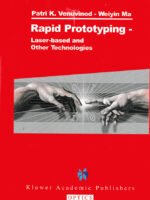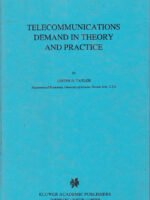-
Designs 2002
₹5,181.00A good example is the proof that there is no projective plane of parameter 10. In that case the computations involved were not different in kind from those which have been done by human brains without electronic assistance; they were merely longer. Computers have also been useful in the study of combinatorial spec trum problems: if a class of design has certain parameters, what is the set of values that the parameters can realize? In many cases, there is a recursive construction, so that the existence of a small number of “starter” designs leads to the construction of infinite classes of designs, and computers have proven very useful in finding “starter” designs.
₹15,699.00 -
Applications of Hyperstructure Theory
₹6,666.00Since the beginning, the Hyperstructure Theory and particu- larly the Hypergroup Theory, had applications to several domains. Marty, who introduced hypergroups in 1934, applied them to groups, algebraic functions and rational fractions. New applications to groups were also found among others by Eaton, Ore, Krasner, Utumi, Drbohlav, Harrison, Roth, Mockor, Sureau and Haddad. Connections with other subjects of classical pure Mathematics have been determined and studied: * Fields by Krasner, Stratigopoulos and Massouros Ch. * Lattices by Mittas, Comer, Konstantinidou, Serafimidis, Leoreanu and Calugareanu * Rings by Nakano, Kemprasit, Yuwaree * Quasigroups and Groupoids by Koskas, Corsini, Kepka, Drbohlav, Nemec * Semigroups by Kepka, Drbohlav, Nemec, Yuwaree, Kempra- sit, Punkla, Leoreanu * Ordered Structures by Prenowitz, Corsini, Chvalina IX x * Combinatorics by Comer, Tallini, Migliorato, De Salvo, Scafati, Gionfriddo, Scorzoni * Vector Spaces by Mittas * Topology by Mittas , Konstantinidou * Ternary Algebras by Bandelt and Hedlikova.
₹20,199.00 -
Rapid Prototyping
₹4,851.00In the first approach, we take a material and apply the needed forces to deform it to the required shape, without either adding or removing material, i. e. , we conserve material. Many industrial processes such as forging, casting, sheet metal forming and extrusion emulate this approach. A problem with many of these approaches is that they focus on form generation without explicitly providing any means for controlling material composition. In fact, even form is not created directly. They merely duplicate the external form embedded in external tooling such as dies and molds and the internal form embedded in cores, etc. Till recently, we have had to resort to the ‘subtractive’ approach to create the form of the tooling.
₹14,699.00 -
Telecommunications Demand in Theory and Practice
₹6,560.00Telecommunications Demand in Theory and Practice is without peer in the documentation and analysis of price elasticities of demand for telecommunications services. This new book also includes a comprehensive bibliography with over 500 entries related to telecommunications demand and pricing. Telecommunications Demand will appeal to both academic and consulting economists, telecommunications industry analysts and regulators, and to teachers of courses in applied econometrics and regulated industries.
₹20,499.00
- Home
- Categories
- Architecture
- Agriculture and Farming
- Business & Management
- Engineering
- Fashion & Textiles
- General and References
- Humanities & Social Science
- Islam
- Library Science
- Literature & Literary Studies
- Mathematics & Statistics
- Media, Information & Communication Industries
- Medicine
- New Arrivals
- On Sale
- Science & Technology
- Sports
- Top Selling
- Travel & Tourism
- Annual Reviews
- Exclusive
- Blog
- Others






